Analytical Models for Grain Size Determination of Metallic Coatings and Machined Surface Layers Using the Four-Point Probe Method
Abstract
:1. Introduction
2. Materials and Methods
3. Results
3.1. Modeling of Different Grain Shapes
3.1.1. Resistance Measurement Parallel to the Cylinder Axis (CA) of Cylindrically Shaped Grains
3.1.2. Resistance Measurement Perpendicular to the Cylinder Axis of Cylindrically Shaped Grains
3.1.3. Resistance Measurement of Spherically Shaped Grains
3.2. Resistance Measurements of a Surface Layer/Coating on Top of Bulk Material
3.2.1. Surface Layer/Coating with Cylindrically Shaped Grains—Resistance Measurement Parallel to the CA
3.2.2. Surface Layer/Coating with Cylindrically Shaped Grains—Resistance Measurement Perpendicular to the CA
3.2.3. Surface Layer/Coating with Spherically Shaped Grains
3.2.4. Bulk Material with Cylindrically Shaped Grains—Resistance Measurement Parallel to the CA
3.2.5. Bulk Material with Cylindrically Shaped Grains—Resistance Measurement Perpendicular to the CA
3.2.6. Bulk Material with Spherically Shaped Grains
4. Discussion
- γ can be considered constant, i.e., identical for all materials or identical for the surface layer/coating and bulk material.
- Grain boundaries can be combined with the above-mentioned resistance offsets Roff and Roff, L. Then, the grain-boundary-related terms in the equations can be omitted, which leads to the elimination of the parameters f and lgb from the equations. In addition, qc = 1 can be used in the case of cylindrically shaped grains measured perpendicular to the CA when grain boundaries are not explicitly included.
- The sample needs to be measured in two directions, i.e., parallel and perpendicular to the CA of the cylindrically shaped grains.
- The sample can be measured in one direction if one of the geometry-related parameters is already known, e.g., from microstructural investigations.
- Two different samples can be measured in one direction if one of the geometry-related parameters is constant in both samples.
- Two samples with an identical grain size and shape but different dL can be measured in one direction, e.g., different coating thicknesses.
- Grain size and shape
- ○
- There is a distribution of grain sizes and—possibly—grain shapes, which cannot be described by the models. Only mean sizes are considered.
- ○
- Typically, the grain shape is irregular. The models consider mean shapes only.
- ○
- The grain size and shape can gradually change near the interface between the surface layer/coating and bulk, which cannot be described by the models.
- ○
- Typically, the grains are not perfectly aligned in rows, which causes deviations between the modeled and the measured electrical resistances.
- ○
- The assumption of a strict electrical separation of the rows of grains is likely not entirely fulfilled.
- ○
- The maximum grain size is limited by the measurement range and resolution of the four-point probe device. With increasing grain size, the measured resistance decreases and the resistance change diminishes, which reduces the accuracy when matching the experiment and model. The maximum grain size is expected to be about 200 µm for materials with a low resistivity.
- ○
- For grain sizes above 1 µm, the resistivity is expected to be constant. As this is a crucial requirement when comparing different samples, the grain sizes should not be significantly smaller than 1 µm.
- Microstructural features
- ○
- The chemical composition and thus the resistivity ρ can gradually change near the interface, e.g., for coatings after a heat treatment, which cannot be described by the models.
- ○
- The porosity of the surface layer/coating or the bulk material is not explicitly considerer in the model. Porosity can cause deviations in the form of seemingly lower grain sizes. An adjusted resistivity can be used to account for porosity.
- ○
- Second phases are not included in the models. Precipitates can be partially accounted for by an adjusted resistivity. However, larger phase fractions of a secondary phase would add an additional set of parameters, which cannot be determined accurately with adequate experimental effort.
- ○
- Surface roughness as well as rough interfaces between the surface layer/coating and bulk material cannot be described by the models. Flat surfaces and interfaces are assumed.
- Material: Although no explicit assumptions are made that limit the materials, the following restrictions have to be considered:
- ○
- In semiconductors, microstructural features (such as residual stresses in the material or as a consequence of a coating process) or doping can change the resistivity of the material significantly. Thus, the model calibration cannot be performed easily, and the models should only be applied to metals.
- ○
- If the resistivities of the surface layer/coating and substrate differ significantly, then the highly resistive material will have a very low impact and might not be derived from the models within the experimental accuracy.
- Layer thickness:
- ○
- For very thick layers with high resistivity, the substrate only has a small impact on the measured resistance value. Thus, within the experimental limits, the grain size of the substrate cannot be calculated accurately.
- ○
- The low impact of surface layers/coatings with only a small thickness or with a limited difference from the underlying bulk material on the measured resistance will cause inaccurate experimental results, which prevent accurate calculations. Additionally, thin layers might not cover the surface completely or might be penetrated by the four-point probe tips, which would make them unsuitable for measurement.
- ○
- Local variations in the thickness dL cannot be described by the models.
5. Conclusions
- grain boundaries;
- intermediate volumes, i.e., no hollow volumes in the material;
- double-layered systems with different grain shapes and sizes in each area.
Author Contributions
Funding
Institutional Review Board Statement
Informed Consent Statement
Data Availability Statement
Conflicts of Interest
References
- Stampfer, B.; González, G.; Gerstenmeyer, M.; Schulze, V. The Present State of Surface Conditioning in Cutting and Grinding. J. Manuf. Mater. Process. 2021, 5, 92. [Google Scholar] [CrossRef]
- Schmidt, R.; Strodick, S.; Walter, F.; Biermann, D.; Zabel, A. Analysis of the functional properties in the bore sub-surface zone during BTA deep-hole drilling. Proc. CIRP 2020, 88, 318–323. [Google Scholar] [CrossRef]
- Meyer, S.; Wiese, B.; Hort, N.; Willumeit-Römer, R. Characterization of the deformation state of magnesium by electrical resistance. Scr. Mater. 2022, 215, 114712. [Google Scholar] [CrossRef]
- Jedamski, R.; Heinzel, J.; Karpuschewski, B.; Epp, J. In-Process Measurement of Barkhausen Noise for Detection of Surface Integrity during Grinding. Appl. Sci. 2022, 12, 4671. [Google Scholar] [CrossRef]
- Fricke, L.V.; Basten, S.; Nguyen, H.N.; Breidenstein, B.; Kirsch, B.; Aurich, J.C.; Zaremba, D.; Maier, H.J.; Barton, S. Combined influence of cooling strategies and depth of cut on the deformation-induced martensitic transformation turning AISI 304. J. Mater. Process. Technol. 2023, 312, 117861. [Google Scholar] [CrossRef]
- Mayadas, A.F.; Shatzkes, M. Electrical-Resistivity Model for Polycrystalline Films: The Case of Arbitrary Reflection at External Surfaces. Phys. Rev. B 1970, 1, 1382–1389. [Google Scholar] [CrossRef]
- Tellier, C.R. Size and Grain-Boundary Effects in the Electrical Conductivity of Thin Monocrystalline Films. Electrocomp. Sci. Tech. 1978, 5, 456185. [Google Scholar] [CrossRef]
- Bedda, M.; Messaadi, S.; Pichard, C.R.; Tosser, A.J. Analytical expression for the total electrical conductivity of unannealed and annealed metal films. J. Mater. Sci. 1986, 21, 2643–2647. [Google Scholar] [CrossRef]
- Mannan, K.M.; Karim, K.R. Grain boundary contribution to the electrical conductivity of polycrystalline Cu films. Phys. F Met. Phys. 1975, 5, 1687–1693. [Google Scholar] [CrossRef]
- Lim, J.W.; Isshiki, M. Electrical resistivity of Cu films deposited by ion beam deposition: Effects of grain size, impurities, and morphological defect. J. Appl. Phys. 2006, 99, 094909. [Google Scholar] [CrossRef]
- Plombon, J.J.; Andideh, E.; Dubin, V.M.; Maiz, J. Influence of phonon, geometry, impurity, and grain size on Copper line resistivity. Appl. Phys. Lett. 2006, 89, 113124. [Google Scholar] [CrossRef]
- Day, M.E.; Delfino, M.; Fair, J.A.; Tsai, W. Correlation of electrical resistivity and grain size in sputtered titanium films. Thin Solid Film. 1995, 254, 285–290. [Google Scholar] [CrossRef]
- Learn, A.J.; Foster, D.W. Resistivity, grain size, and impurity effects in chemically vapor-deposited tungsten films. J. Appl. Phys. 1985, 58, 2001–2007. [Google Scholar] [CrossRef]
- Zeng, H.; Wu, Y.; Zhang, J.; Kuang, C.; Yue, M.; Zhou, S. Grain size-dependent electrical resistivity of bulk nanocrystalline Gd metals. Prog. Nat. Sci. Mater. Int. 2013, 1, 18–22. [Google Scholar] [CrossRef]
- Yoo, E.; Moon, J.H.; Jeon, Y.S.; Kim, Y.; Ahn, J.-P.; Kim, Y.K. Electrical resistivity and microstructural evolution of electrodeposited Co and Co-W nanowires. Mater. Charact. 2020, 166, 110451. [Google Scholar] [CrossRef]
- Santos, T.G.; Miranda, R.M.; Vilaça, P.; Teixeira, J.P. Modification of electrical conductivity by friction stir processing of aluminum alloys. Int. J. Adv. Manuf. Technol. 2011, 57, 511–519. [Google Scholar] [CrossRef]
- Metan, V.; Eigenfeld, K. Controlling mechanical and physical properties of Al-Si alloys by controlling grain size through grain refinement and electromagnetic stirring. Eur. Phys. J. Spec. Top. 2013, 220, 139–150. [Google Scholar] [CrossRef]
- Barghout, J.Y.; Lorimer, G.W.; Pilkington, R.; Prangnell, P.B. The Effects of Second Phase Particles, Dislocation Density and Grain Boundaries on the Electrical Conductivity of Aluminium Alloys. Mater. Sci. Forum 1996, 217–222, 975–980. [Google Scholar] [CrossRef]
- Abbas, S.F.; Seo, S.-J.; Park, K.-T.; Kim, B.-S.; Kim, T.-S. Effect of grain size on the electrical conductivity of copper–iron alloys. J. Alloys Compd. 2017, 720, 8–16. [Google Scholar] [CrossRef]
- Bishara, H.; Lee, S.; Brink, T.; Ghidelli, M.; Dehm, G. Understanding Grain Boundary Electrical Resistivity in Cu: The Effect of Boundary Structure. ACS Nano 2021, 15, 16607–16615. [Google Scholar] [CrossRef]
- Mehner, T.; Uland, M.; Lampke, T. Analytical Model to Calculate the Grain Size of Bulk Material Based on Its Electrical Resistance. Metals 2021, 11, 21. [Google Scholar] [CrossRef]

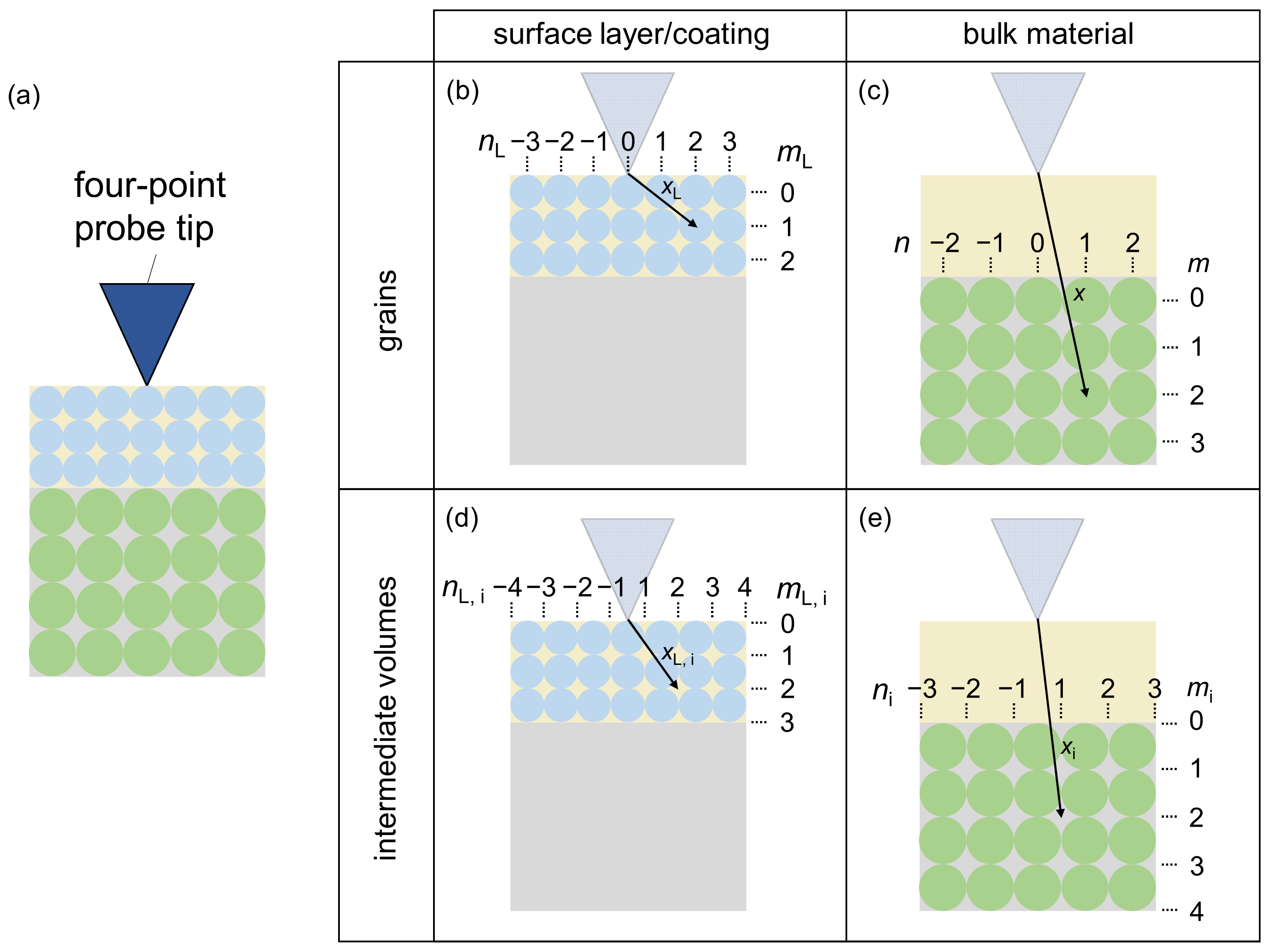

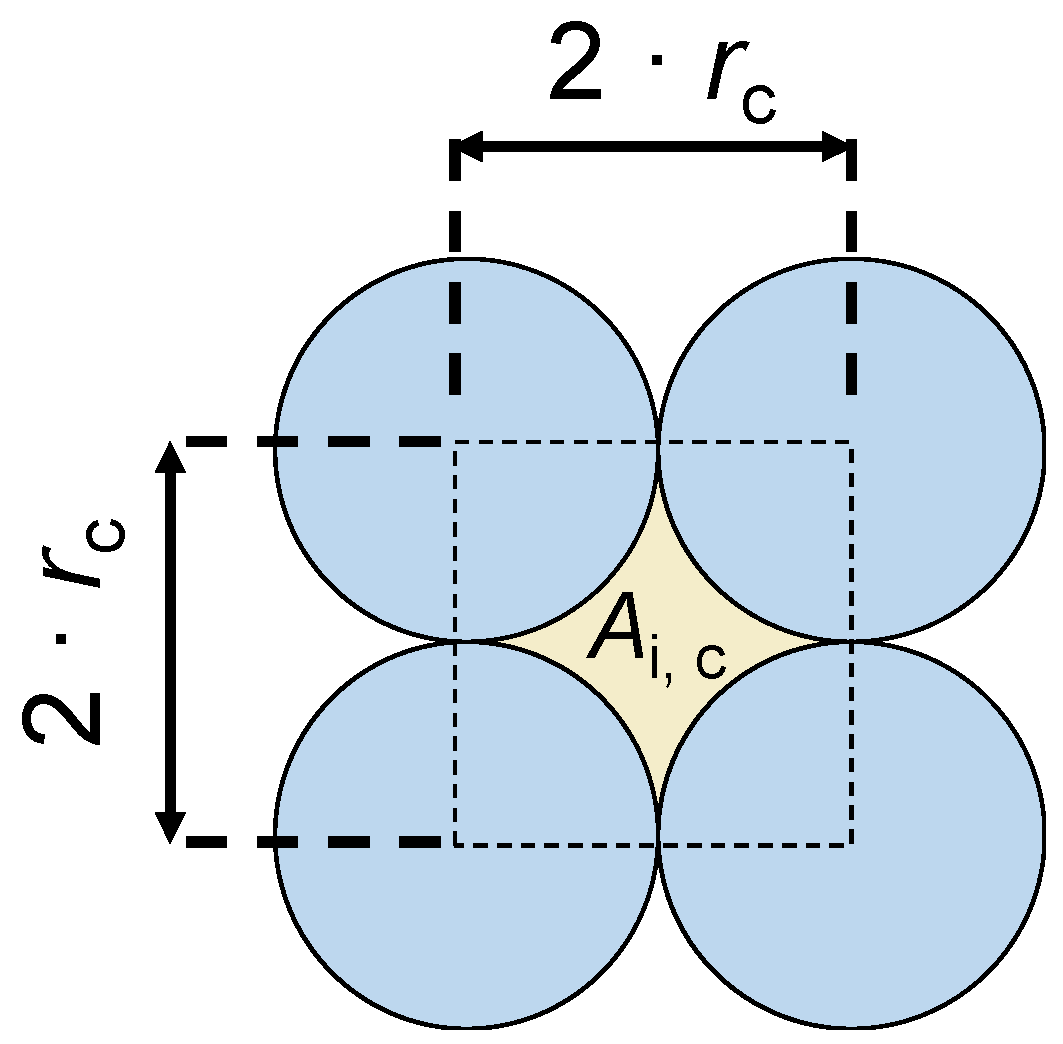
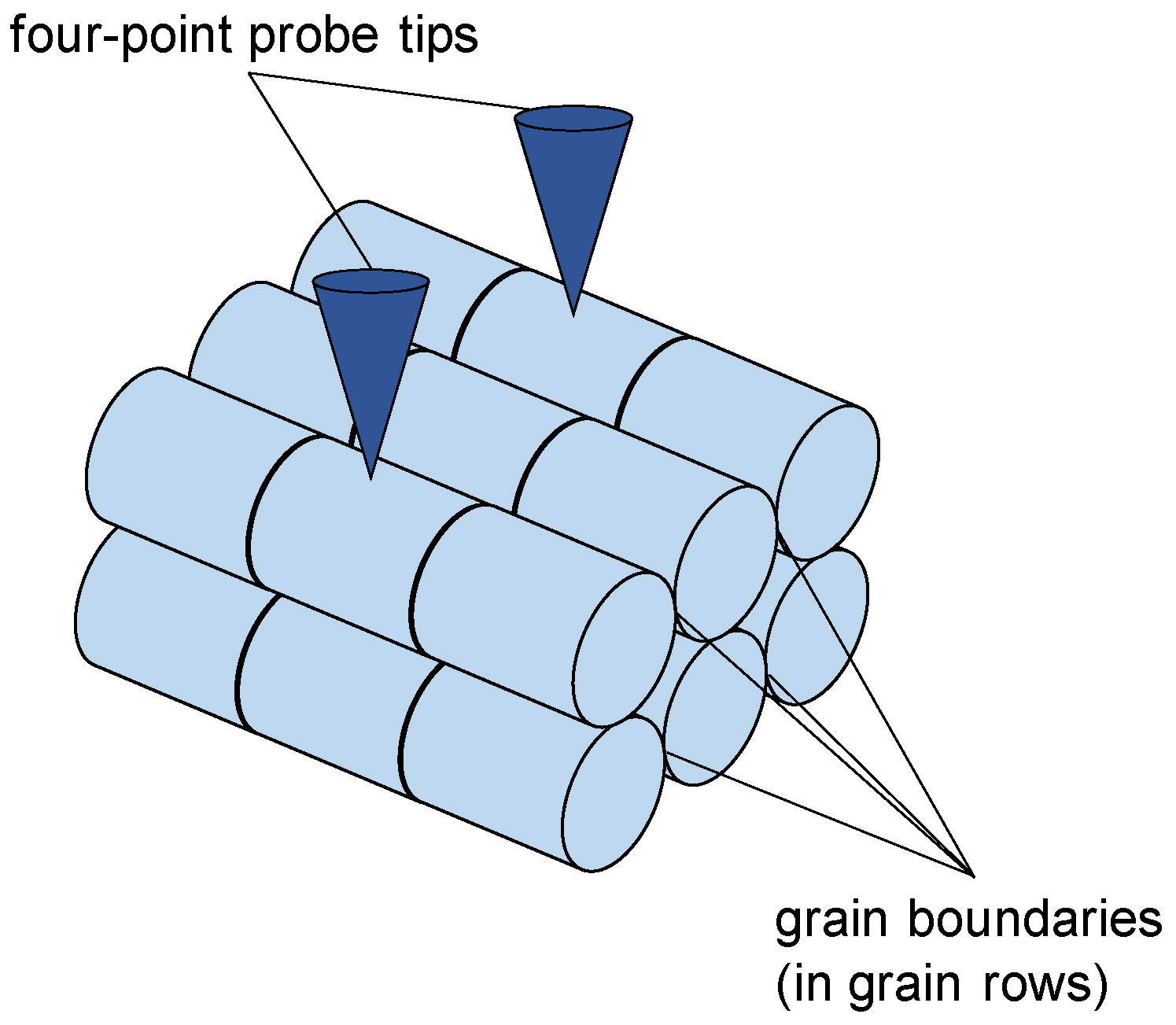

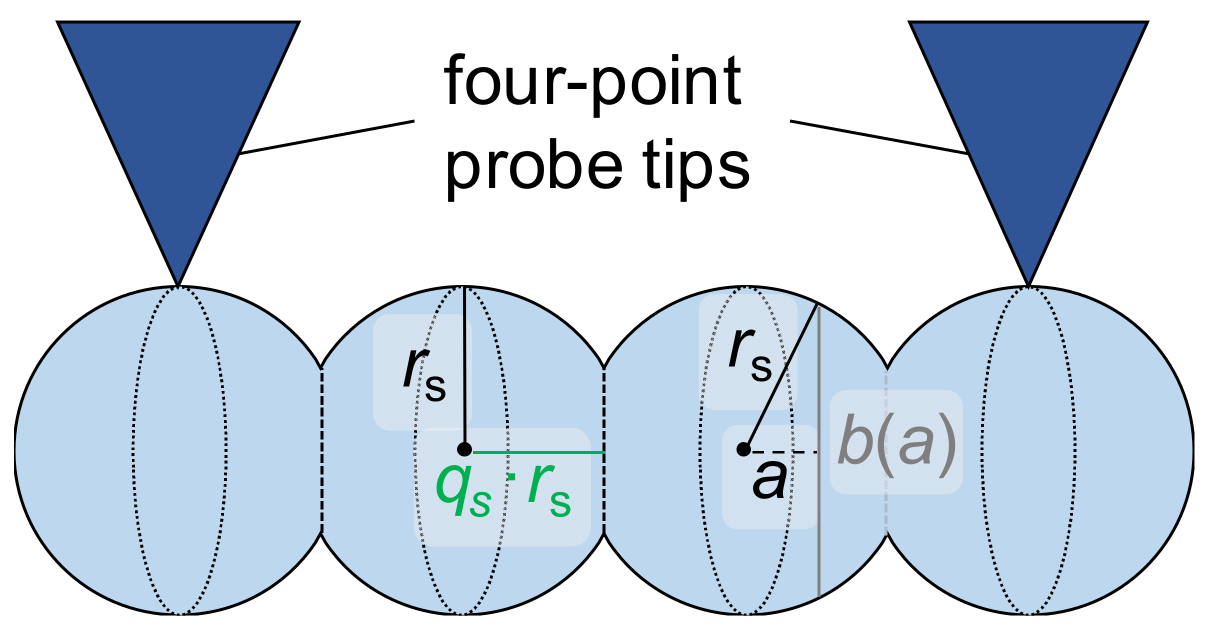
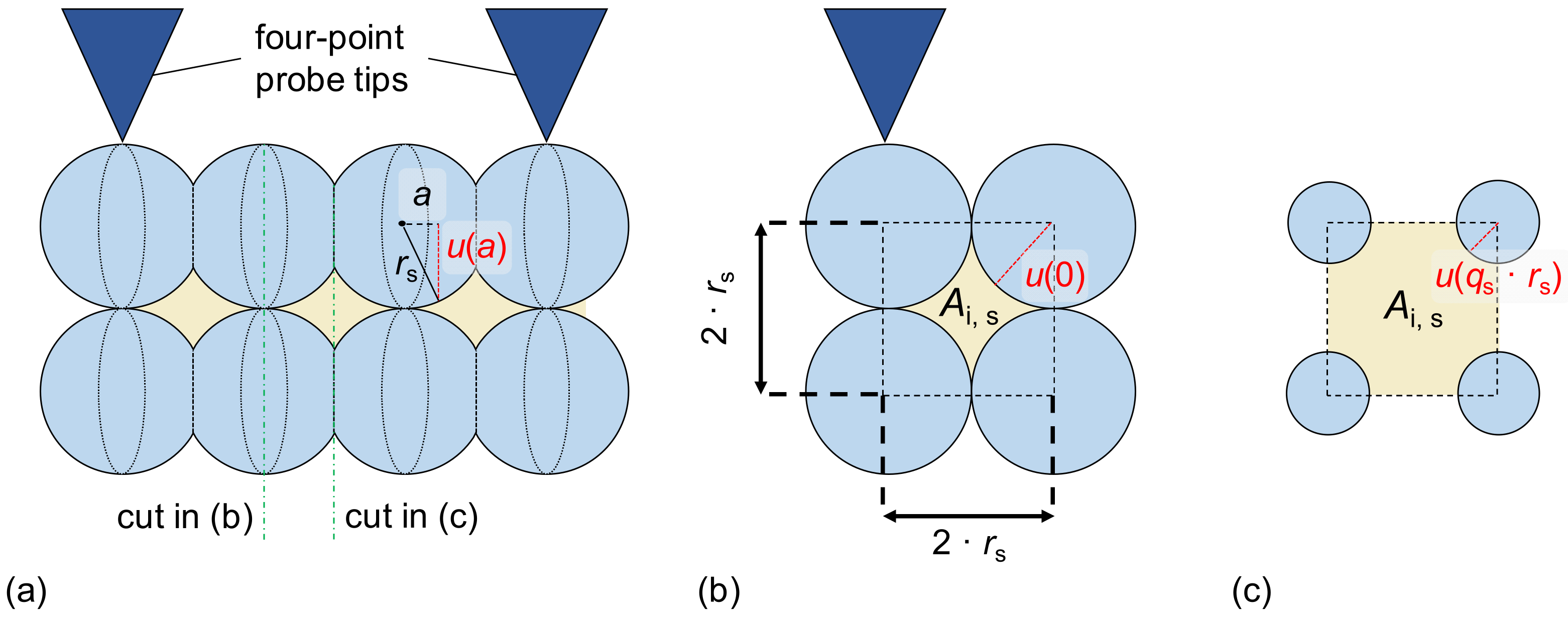
| Parameters | Source of Determination |
|---|---|
| ltips | measured from the used four-point probe |
| ρ | literature |
| grain shapes, dL, q, lgb | investigation of the microstructure or estimation |
| C, γ, f | fitting of calibration samples |
| Parallel to CA | Perpendicular to CA | Spherical | |
|---|---|---|---|
| surface layer/coating | (22), (24), (25) | (27) | (29), (31), (32) |
| bulk material | (34), (36), (37) | (39) | (41), (43), (44) |
Disclaimer/Publisher’s Note: The statements, opinions and data contained in all publications are solely those of the individual author(s) and contributor(s) and not of MDPI and/or the editor(s). MDPI and/or the editor(s) disclaim responsibility for any injury to people or property resulting from any ideas, methods, instructions or products referred to in the content. |
© 2023 by the authors. Licensee MDPI, Basel, Switzerland. This article is an open access article distributed under the terms and conditions of the Creative Commons Attribution (CC BY) license (https://creativecommons.org/licenses/by/4.0/).
Share and Cite
Mehner, T.; Lampke, T. Analytical Models for Grain Size Determination of Metallic Coatings and Machined Surface Layers Using the Four-Point Probe Method. Materials 2023, 16, 6000. https://doi.org/10.3390/ma16176000
Mehner T, Lampke T. Analytical Models for Grain Size Determination of Metallic Coatings and Machined Surface Layers Using the Four-Point Probe Method. Materials. 2023; 16(17):6000. https://doi.org/10.3390/ma16176000
Chicago/Turabian StyleMehner, Thomas, and Thomas Lampke. 2023. "Analytical Models for Grain Size Determination of Metallic Coatings and Machined Surface Layers Using the Four-Point Probe Method" Materials 16, no. 17: 6000. https://doi.org/10.3390/ma16176000





